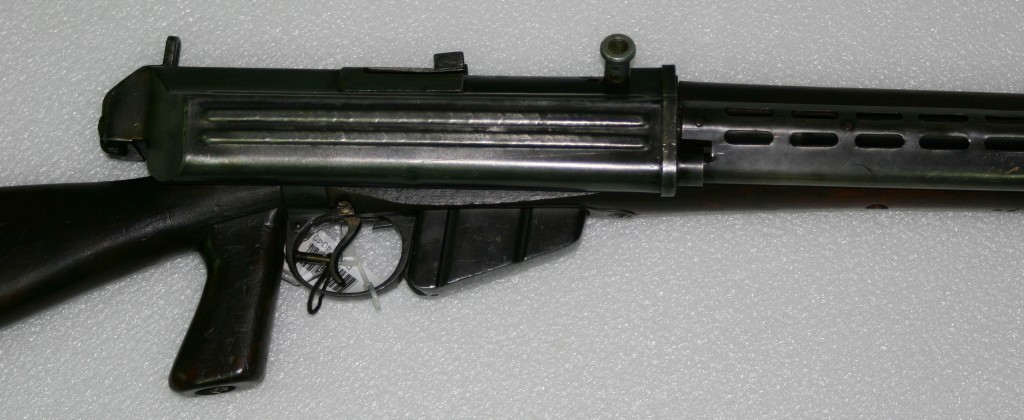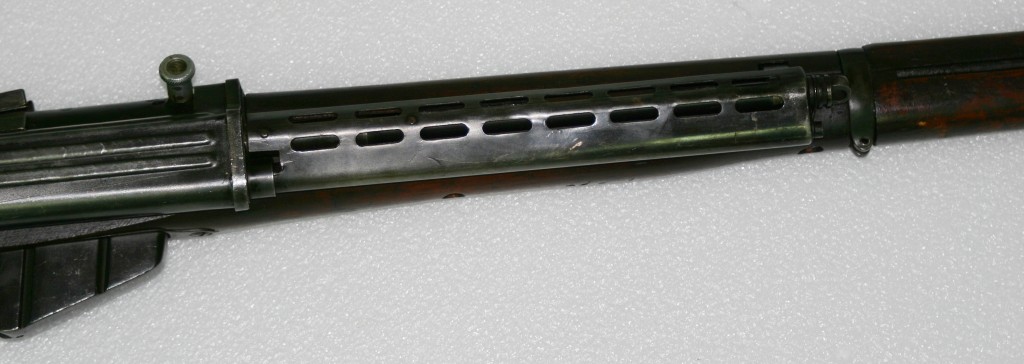As we mentioned earlier this week in the Charlton Automatic Rifle article, the Australian government expressed an interest in converting rifles to Philip Charlton’s self-loading design. Charlton spent several months in Australia negotiating the deal, and it was eventually decided that the Australian manufacturing company Electrolux (which made primarily household appliances) would produce the guns, with Charlton receiving a small royalty for each one. Electrolux built a couple prototype guns, and they differed in several ways from the typical New Zealand Charltons.

First of all, the Electrolux guns were made from No1 MkIII SMLE rifles, instead of the obsolete Lee Metford and Long Lee rifles used in New Zealand. The front end of the rifle was left intact with its wooden furniture and bayonet lug. Information about this Australian offshoot of the Charlton is pretty scarce, but it is possible that the Australians intended to use the guns as shoulder-fired semiauto rifles instead of light machine guns, and this would account for some of their design changes.
The Electrolux guns did have pistol grips, but not a front grip or bipod like the New Zealand guns. They also had sheet metal covers to protect the gas piston and other operating parts. Between these various changes, the Electrolux guns were much cleaner looking than Charlton’s original design. Looking closely, you can see that the buttstock was lengthened by splicing in an extension behind the sling swivel – the original length stock was too short to effectively shoot with he extra hardware added for the semiauto conversion.

Note that while the original Charlton guns used the regular rifle left sight located above the rear of the barrel, the Electrolux version replaced this with a simple aperture sight at the very back of the action cover. This would have made for better practical accuracy by significantly increasing the sight radius of the weapon.
This particular Electrolux rifle is equipped with a standard 10-round SMLE magazine, and we do not know if the Australian planned to use those or replace them with 30-round modified Bren magazines or extended SMLE magazines. The 10-rounder may have been used on the prototypes just for simplicity’s sake.

After the prototype rifles were built, production began on the parts for a large quantity (10,000, according to Charlton’s agreement with the Australian government) of conversions. At some point, however, the project was abandoned, and no production Electrolux guns were ever assembled. Late in the war the Australian government got around to offering their stock of finished parts to New Zealand, but by that time New Zealand had completed the 1500 guns it wanted, and had no need for the parts. What ended up happening to them is up to speculation – they were most likely destroyed, but there is always the tantalizing possibility that they remain crated up in the back of some warehouse. If you happen to know of them, please let us know – we would love to get our hands on Charlton parts!
Because only a handful of prototypes were ever made, the Electrolux Charlton guns are even more rare than the New Zealand version. We know of one in the British Pattern Room collection, and there may be another in a second museum. Unfortunate, because of all the self-loading Enfield conversions, the Electrolux Charlton is by far the most elegant looking.

There is another Charlton gun at the Royal Australian Ordnance Corps Museum at Bandiana, Victoria, Australia. Ive seen it with my own beady eyes
fancy seeing you here Ian! and yes, there’s “one” at bandi, but i’ve seen it displayed with three different magazines……………… so there could be upto three in the collection
The Australian Army Infantry Museum has two, both Australian made. The first is like the example at Bandiana, the “classic” Charlton. The other is like the example shown above which is the last of the rifles put up for trial. The “rifle” version is semi auto only. The documents we have clearly indicate that we used rifles dated from 1890 to the 1930s of both UK and Australian manufacture. The easiest way to quickly ID an Australian made Charlton in its classic configuration is that it is fitted with modified Austen grips
The Canadian War Museum has a Charlton and it appears to be the Australian made version as it has the sheet metal handguard. I have a photo of it on my website being held by the late Barry Gillis, whose World class grenade collection was donated by him to the Canadian War Museum. http://captainstevens.com/military/weapons/grenade/
Hi,
That is indeed an Australian Charlton, check out these docs from the Australian National Archives.
http://recordsearch.naa.gov.au/SearchNRetrieve/Interface/ViewImage.aspx?B=393794
http://recordsearch.naa.gov.au/SearchNRetrieve/Interface/ViewImage.aspx?B=4822107
Cheers
Paul
salutations i have noticed that some 4.000 were actually made is that true (i would love a reply lads)
i believe so
The Electrolux company which makes household appliances is actually from Sweden.
However I find it strange that a Swedish household appliances company would invent an produce weapons down in Australia.
Does anyone have some more backstory to this?